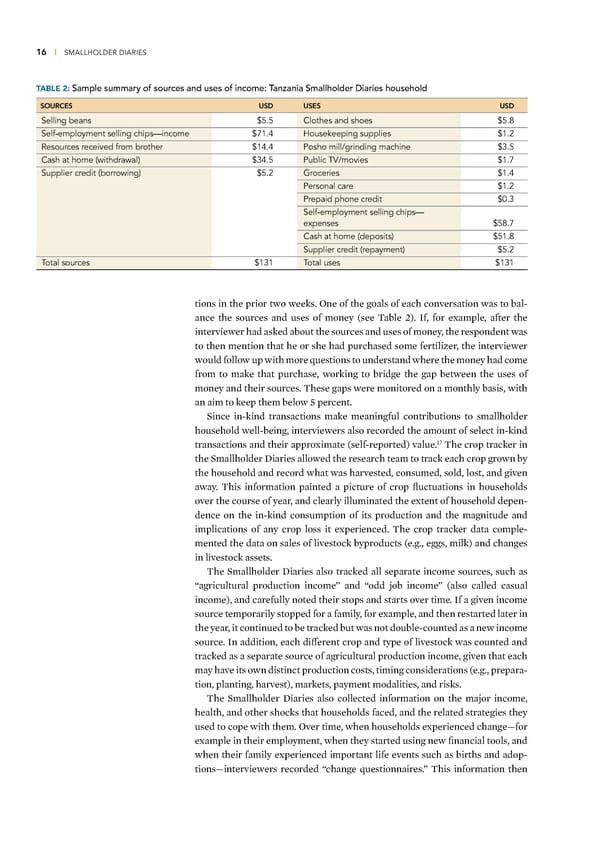16 | SMALLHOLDER DIARIES TABLE 2: Sample summary of sources and uses of income: Tanzania Smallholder Diaries household SOURCES USD USES USD Selling beans $5.5 Clothes and shoes $5.8 Self-employment selling chips—income $71.4 Housekeeping supplies $1.2 Resources received from brother $14.4 Posho mill/grinding machine $3.5 Cash at home (withdrawal) $34.5 Public TV/movies $1.7 Supplier credit (borrowing) $5.2 Groceries $1.4 Personal care $1.2 Prepaid phone credit $0.3 Self-employment selling chips— expenses $58.7 Cash at home (deposits) $51.8 Supplier credit (repayment) $5.2 Total sources $131 Total uses $131 tions in the prior two wees ¦ne of the goals of each conversation was to bal- ance the sources and uses of money (see Œable ‘) €f, for example, after the interviewer had ased about the sources and uses of money, the respondent was to then mention that he or she had purchased some fertili—er, the interviewer would follow up with more uestions to understand where the money had come from to mae that purchase, woring to bridge the gap between the uses of money and their sources Œhese gaps were monitored on a monthly basis, with an aim to eep them below ” percent Since in-ind transactions mae meaningful contributions to smallholder household well-being, interviewers also recorded the amount of select in-ind …• transactions and their approximate (self-reported) value Œhe crop tracer in the Smallholder ‰iaries allowed the research team to trac each crop grown by the household and record what was harvested, consumed, sold, lost, and given away Œhis information painted a picture of crop fluctuations in households over the course of year, and clearly illuminated the extent of household depen- dence on the in-ind consumption of its production and the magnitude and implications of any crop loss it experienced Œhe crop tracer data comple- mented the data on sales of livestoc byproducts (eg, eggs, mil) and changes in livestoc assets Œhe Smallholder ‰iaries also traced all separate income sources, such as “agricultural production income” and “odd „ob income” (also called casual income), and carefully noted their stops and starts over time €f a given income source temporarily stopped for a family, for example, and then restarted later in the year, it continued to be traced but was not double-counted as a new income source €n addition, each different crop and type of livestoc was counted and traced as a separate source of agricultural production income, given that each may have its own distinct production costs, timing considerations (eg, prepara- tion, planting, harvest), marets, payment modalities, and riss Œhe Smallholder ‰iaries also collected information on the ma„or income, health, and other shocs that households faced, and the related strategies they used to cope with them ¦ver time, when households experienced change—for example in their employment, when they started using new financial tools, and when their family experienced important life events such as births and adop- tions—interviewers recorded “change uestionnaires” Œhis information then
 Financial Diaries with Smallholder Families Page 26 Page 28
Financial Diaries with Smallholder Families Page 26 Page 28